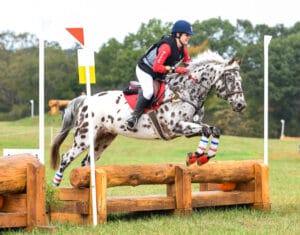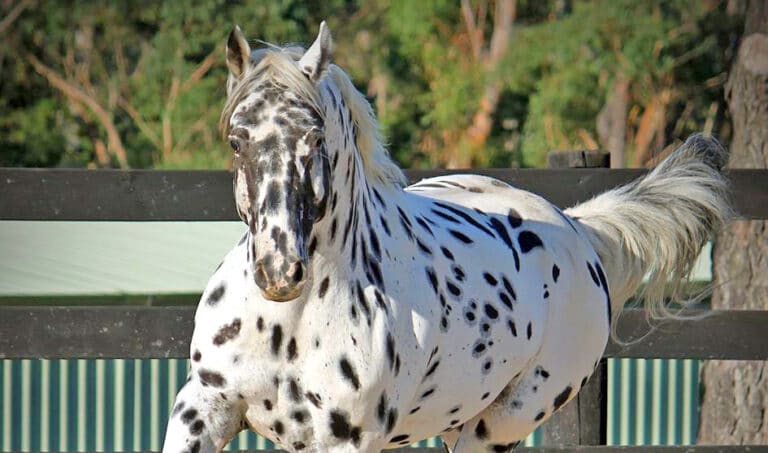Sportaloosas, or Appaloosa Sport Horses are as distinctive as they are athletic, writes MATHILDE GREGOIRE.
Despite being a young breed, the Sportaloosa – also known as the Appaloosa Sport Horse – has rapidly grown in popularity over the past few years, generating interest internationally and competing at top levels in equestrian Olympic disciplines. While their striking coat color makes them esthetically pleasing, their cool and easy temperament also qualifies them as a pleasure breed and a wonderful family horse.
A potted history
Spotted horses genetically predate any horses imported to the Americas by Spanish settlers, and the Appaloosa’s eye-catching markings have since made it popular around the world. Originating from the wild Mustangs selectively bred by the Nez Perce, a First Nation tribe in the US Pacific Northwest, they were once referred to as Palouse horses after the nearby Palouse River, their name evolving over time to Appaloosa.
In the United States, the classification of Appaloosa Sport Horse applies to horses of light and athletic build, resulting from crosses between Appaloosa and various breeds of sport horse. Initially registered within the Appaloosa Sport Horse Association, its dissociation in 2014 resulted in transfer of the breed’s management to the American Warmblood Society & Sporthorse Registry, creating a specially dedicated category within the registry.
Today, the Sportaloosa is a non-breed specific spotted sport horse that excels in a variety of disciplines, including dressage, jumping, and eventing. Some Appaloosa Sport Horses have already won international acclaim for their Olympics performances. In 2016, Paralympic dressage rider Anne Dunham and her spotted Leopard stallion LJT Lucas Normark famously won the team gold and two individual silver medals for Great Britain.

Anne Dunham and LJT Lucas Normark at the FEI Para-Equestrian Dressage European Championships in Deauville, France (Image by John Stroud Media).
A star breed
In Australia and New Zealand, Sportaloosa International is the governing body for spotted athletic horses. To qualify, Sportaloosas must exhibit Leopard Complex (LP) gene markings, which can be inherited from Appaloosas, Knabstruppers and other spotted breeds, and are selected based on athletic performance. Historically, it was
not possible to register horses resulting from crosses between Appaloosa and Knabstrupper or other sport horses. At the time, foals could only be documented with the breed registry of one of their parents. Today, crosses with Warmbloods, Thoroughbreds, Arabians, Andalusians, Lusitanos, Friesians and Lipizzaners, as well as Quarter Horses are all accepted.
Characteristics
Sportaloosa International defines Sportaloosas by three key characteristics: an easy temperament, athletic stamina, and a range of unique coat pattern which stem from the LP gene. It is thought that inheriting this specific gene mutation impacts not only coat color, but also influences the temperament of these horses, which are often very relaxed, friendly, and easy-going.
As a dominant mutation, only one copy of the LP gene is needed to express the phenotype, or Leopard Complex characteristics. A second copy of the gene unlocks the full spectrum of patterns, with white patches ranging from a few discrete spots to a completely white coat. Secondary LP characteristics also include mottled skin around the eyes, muzzle, and genitalia, and a white sclera around the iris of the eye, as well as striped hooves.
With a fine head, lightly curved neck, and strong legs and hindquarters, the Sportaloosa exhibits the athletic abilities of a Warmblood. Sportaloosa International has separate registries for horses and ponies: Sportaloosa horses are between 15 and 16.2hh, while their pony counterparts stand at less than 14hh.
Their unique coat markings are not the only striking characteristic of the Sportaloosa. Their calm, trainable temperament makes them ideal family horses, traits that are also highly desirable in horses competing at top levels.

Athletic and cool headed, Sportaloosas excel in many disciplines, including eventing (Image by USEA/Jessica Duffy Photography).
LP gene health issues
Sportaloosas, Appaloosas, Knabstruppers, and related breeds showing a Leopard Complex coat pattern are susceptible to congenital stationary night blindness (CSNB), an inherited and non-progressive genetic disease. When two copies of the LP gene are present (homozygous), horses express the phenotype that causes night blindness. While it is difficult to assess the degree of blindness in affected horses, some may exhibit increased anxiety and disorientation at nighttime and are more prone to injuries in low light conditions. DNA tests for the LP homozygous mutation are available.
Equine recurrent uveitis (ERU), also known as ‘moon blindness’ is an ocular disease that causes inflammation of the uveal tract in the eye, which can lead to blindness. Researchers have found that compared to other breeds, Appaloosas have a significantly increased probability of developing the ailment and becoming blind. Findings suggest a link with the LP gene is a causal risk factor, and horses that have both copies of the mutated LP gene (homozygous) should be monitored for any signs of ERU.
The unique Sportaloosa, with its variety of body types and heights, is competitive in dressage, jumping and eventing, as well as in the show ring, western events and Pony Club. And it’s that versatility combined with their calm and tractable nature, that has made them a very popular, as well as a distinctive breed.
For more information visit Sportaloosa International, and if you’re interested in buying a Sportaloosa, take a look at Cayuse Sportaloosas.
Feature Image: Lori’s Flashpoint Af Lyn, a stunning black Leopard Knabstrupper stallion from Australia’s Cayuse Sportaloosa (Image courtesy Cayuse Sportaloosa).



